» Home
» About
» Membership
» Journal
» Sparoza Garden
» Branches
» MGS Forum
» Seed Exchange
» Donations
» MGS Excursions
» Information
» Members' Gardens
» Book Reviews
» News & Views
» Contact
» Search
Information and
resources for Greece
Ελληνικό ιστότοπος του MGS
|
The Peloponnese Branch of the MGS
Past Events
May 2016
Exploring the Northern Taygetos Mountains
The purpose of this excursion, meticulously organized by Kay-Elvina Sutton of the Peloponnese Group, was to explore three gorges leading from Kastori to Georgitsi, some 20 km north of Sparta in the Peloponnese. We had a lot of help from local officials, but the weather was beyond Kay’s control: it was cold and wet for late May.
The party assembled on 20 May at the excellent Museum of the Olive and Greek Olive Oil in Sparta. First we visited the Sainopoulio Park west of the town to examine the many tree plantings and to picnic at the modern open-air theatre, against the magnificent backdrop of Mystras and the Taygetos massif.
We moved to ancient Sparta with its once impressive Roman theatre, which seated 16,000 spectators, i.e. a little less than the population of the modern town. British archaeologists have shown that the theatre included movable scenery, perhaps an innovation for the first century AD.
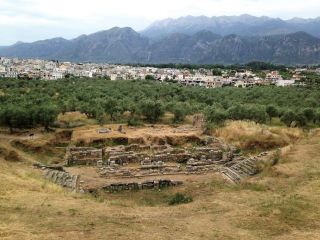
Roman theatre in ancient Sparta
Kay then took us to the town’s externally modest repository of mosaics. This is rarely open to the public and is about to undergo a long period of renovation. The energetic curator showed us a Roman mosaic (AD 200) of the rape of Europa which has been used at the model for the Greece’s two-Euro coin. Even more extraordinary – and frightening – was a Hellenistic (BC 300) head of Medusa, made from crudely-cut black, white and brown stones. Over 2000 square metres of Roman mosaics have been uncovered in Sparta in recent years: it was a wealthy town.
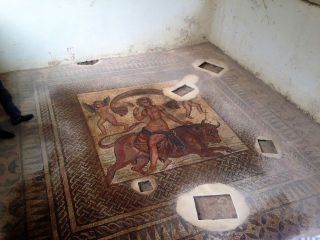
The rape of Europa
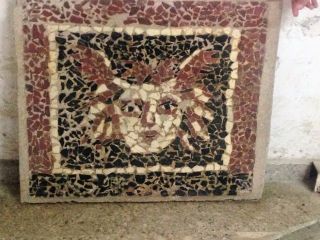
Head of Medusa
Then we drove to our overnight accommodation in Kastori, at 500m altitude. It is an enchanting small town, perhaps a market-town in English terms: the regional centre. The quiet main street has nothing of the 21st century – no banks, no supermarket chains, no fast-food outlets and no dispensers of electronic gadgets, only old shops and cafés which may have changed little in 50 years.
On Saturday 21st we divided into two groups to tackle the Myli gorge leading up to Georgitsi. One group, led by intrepid walkers Barbara and Dennis Balfour, took us upwards through dense vegetation and under threatening skies. At the halfway point, where the path narrows to a few inches and where you have to cling to a wire to avoid falling off, we turned round. The heavens opened. We descended and ate sodden sandwiches with the wiser group who had decided to explore the lower and flatter part of the gorge.
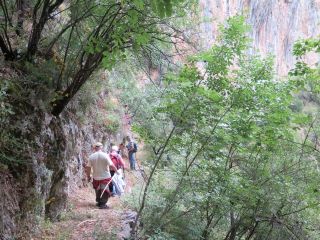
Walking in the gorge
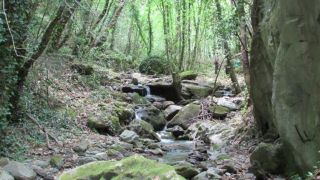
The stream
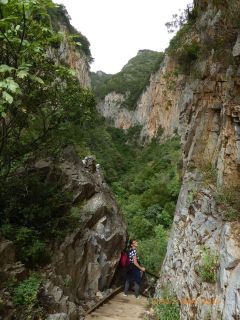
In the afternoon, after a change into drier clothes, we inspected the small church of Panagia Mesosporitissa cut into the mountainside, and we enjoyed fine views of Kastori. The evening was spent exploring Georgitsi at 1000 m: a magnificent stone-built village, once one of the largest and richest in Laconia. Its many levels are connected by steep flights of steps and kalderimia (stone paths). It’s known locally as the ‘Balcony of the Taygetus’: with good reason - the view is breathtaking, extending from Tripolis in the north to the Gulf of Laconia in the south. We had a splendid – wild boar-heavy – supper in the Platanos tavern in main square. We were grateful for the heat of open fires. We did not sample another local specialty – volvoi (bulbs), the pickled roots of the tassel hyacinth. Georgitsi is also famed for the quality of its tsipouro (eau de vie).
On Sunday 22nd we visited the important Mycenean site at Pellana. It is a mystery why this is so little known: there are five impressive beehive tombs cut into the sandstone. The largest, over 10 m in diameter, is second in size to the tomb of Agamemnon at Mycenae. A sixth has yet to be explored. The tombs appear to have been ransacked in classical times and little is known about their contents or the society that produced them. Pellana is mentioned by the traveler Pausanias in the 2nd century AD. It was clearly once a much more important place than it is now. A local archaeologist has argued that this was the site of Menelaios’s palace, from which Paris abducted Helen, thus launching the Trojan War. However, most experts agree that the palace is likely to have been on a small hill, now called the Menelaion, overlooking Sparta.
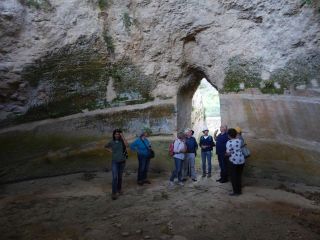
Doorway to the Mycenaean tomb, the largest one at Pellana
We enjoyed an excellent lunch in the small square of the village and swapped plants, before going our separate ways.
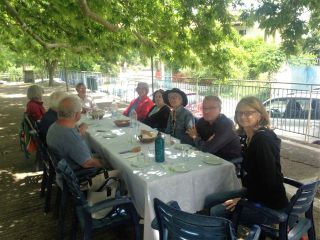
Lunch and plant exchange
This was MissIon Unaccomplished because we failed to do the full walk from Kastori to Georgitsi. Another time perhaps. Unusually for an MGS event, it was light on wild plants: we saw orchids (Anacamptis pyramidalis and Orchis italica), Madonna lilies (Lilium candidum) and many wild flowers around Pellana.
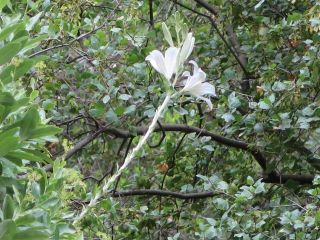
Madonna lilies

Greece’s largest wasp - Scolia flavifrons
There were neat gardens and orchards in Kastori and Georgitsi. This an area which gets little attention from outsiders. It has dense forests (especially chestnut), dramatic cliffs and ravines, and churches and monasteries perched on impossible crags. Many of the villages have a charm lacking in more modern parts of Greece. A recently completed Sparta-Tripolis motorway, with an exit at Pellana, makes the region more accessible. Whether this will bring social and economic change remains to be seen.
Text by Christopher Hulse
May 2015
Visit to home of the late Patrick Leigh Fermor, Kardamyli
A perfect spring day welcomed the MGS Peloponnese branch to the late Patrick Leigh Fermor's legendary home near the Mani village of Kardamyli, in the Peloponnese. Irini Geroulanou, deputy director of the house's new owner, the Benaki Museum, kindly offered us the opportunity to wander around the beautiful house and grounds, set among olive groves on a promontory facing west over the Messinian Gulf.
The museum is currently raising funds to restore the site so it can be used, in accordance with Leigh Fermor's wishes, as a writers' retreat. All the contents of the house, including the 6,000-volume library, have been catalogued and photographed, while the more valuable items have been put in storage until the project is complete.
The house, which has stood empty since the author's death in 2011, was designed by the owner and his wife Joan in collaboration with the architect Nikos Hadjimichalis. In the living room, where French windows let in light and overlook the sea, there are bookcases spread around the walls and comfortable armchairs and sofas nearby. The stone archways of the loggia, the spacious living areas and the terrace (the location for scenes in the recent film ‘Before Midnight’) were instantly recognisable to those of us familiar with his writing, and particularly with the recent biography of Leigh Fermor by Artemis Cooper.
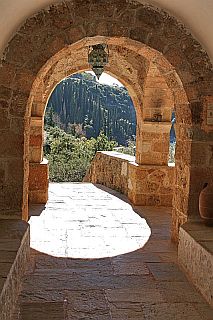
The loggia
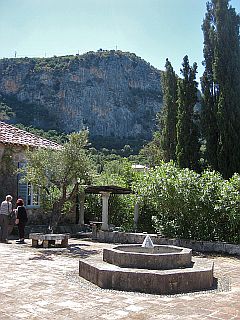
The terrace and fountain
The grounds, enclosed by a stone wall and overlooking the sea through a vista of cypresses and olive trees, are composed of separate areas providing private corners in which to read, sit and chat or simply enjoy the views. A hedge of rosemary separates the main house from a studio that houses Paddy's study.
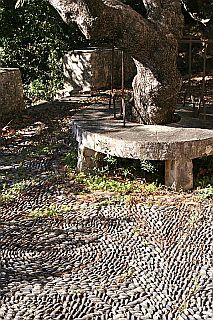
A quiet place to read
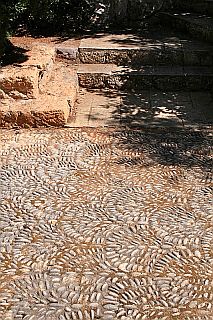
Areas of pebble mosaic add visual interest and charm
For landscape architect Elli Pangalou, a Benaki Museum volunteer involved in the restoration of the garden, the most interesting thing about it is the way that the different levels are arranged to make the most of the views. ‘As far as the softscape, or planting, is concerned, there isn't much variety or biodiversity’, explained Pangalou. ‘The guidelines set for the layout of this garden were mainly to try to use indigenous species. Above all, Leigh Fermor tried to have the vistas outside the house viewed through very interesting frames. For example, as you enter the house, what you see is a view towards the sea and a typical Mediterranean landscape with a hillside of cypresses. But I think the most interesting thing here is the genius loci of the place and the power of the person who made it’, added Pangalou, ‘so this is what we are working on, the legacy that he left.’
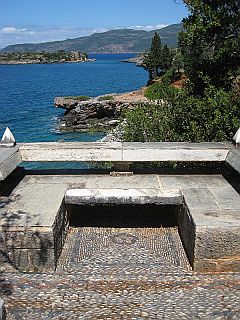
The view to the Messinian Gulf
When the project is completed, there will be plenty of opportunities for visitors to enjoy the atmosphere. According to Geroulanou, apart from the residential programmes for writers, there will be guided tours and open days for the general public. Worth waiting for indeed!
Text by Yvette Varvaressou
Photos by Katerina Georgi
November 2013
MGS Peloponnese group – 3-day event
Day one - Wild flower tour of the western Taygetos
Following a substantial buffet meal and registration the previous evening, 29 intrepid MGS members, from Greece and beyond, gathered in the sun outside Stoupa school at 9am to embark on a ‘mystery’ tour of sites in the western Taygetos mountains, led by Melvyn Jope and John Fielding.
Having passed through Neochori and Pyrgos, we noted many Crocus boryi growing along the roadside and in some cases seeming to force their way up through the tarmac. In the rocky terraces of olives there were colourful patches of Cyclamen graecum, and, coming into Kastania, there was evidence of the effect of Seiridium cardinale, the microscopic fungal parasite that is the pathogenous agent of a disease commonly called cypress canker. Unfortunately, this disease can be seen affecting Cupressus sempervirens all over the Mani.
After taking a wrong turn at Kastania, we were able to admire the skills of our imperturbable driver as he reversed and squeezed the coach through narrow village roads with overhanging balconies. We were on our way to Saidona when the wonderfully coloured Iris unguicularis was spotted from the coach. Out came the cameras, and several minutes were spent trying to get just the right shot. Among other species in evidence here were Clinopodium nepeta (syn. Calamintha nepeta), Leontodon taraxacoides, Verbena officinalis and Teucrium polium.
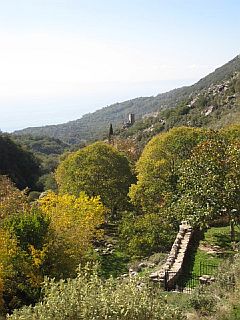
Iris unguicularis at Saidona
(Photo Graham Aveyard)
Our organisers urged us back on to the coach and we continued to our first destination - Agios Samouil monastery. Getting to the monastery itself involved a climb up a stony path, slippery from recent rains, but MGS members are nothing if not determined and we all made it to the site. There Melvyn demonstrated the differences between Cyclamen species (the subject of a talk he gave to the group last year), and there were many around to photograph. A fine old Ficus carica was growing near the monastery, and, as we were walking near the tree, a wonderful aroma from Clinopodium nepeta was released.
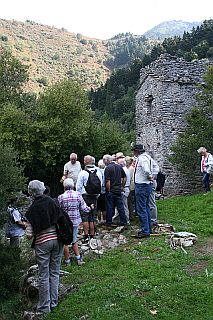
Melvyn Jope talking about Cyclamen
(Photo Katerina Georgi)
We returned to the road and walked along it to the next site, Vaidenitsa monastery. There was a well-defined path to this monastery with Phlomis fruticosa (Jerusalem sage)and Thymbra capitata (syn. Coridothymus capitatus)among the rocks above the path. The monastery has a very special atmosphere, partly due to the deep shade cast by the many mature walnut trees planted in the grounds. We eventually returned to the coach and journeyed on to Milia, where we stopped for a picnic lunch in the plateia. On the way, we were able to view the glorious colours of the Mani in the autumn, with golden yellows and oranges mingled with the fresh green of Euphorbia, while John Fielding described the local vegetation for us. Phrygana (the eastern Mediterranean version of garrigue) consists of low, cushion-shaped thorny shrubs, such as the endemic Euphorbia acanthothamnos (Greek spiny spurge) and Phlomis,while maquis, a vegetation of the Mediterranean region, occurs mainly on the lower slopes of mountains bordering the sea. Many of the shrubs are aromatic, such as mint, laurel, lentisc and myrtle. Olive, fig, buckthorn, kermes oak, and other small trees are found throughout the maquis, and they may grow into larger specimens.
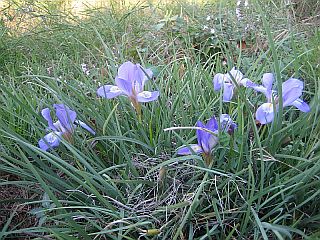
View from Vaidenitsa monastery
(Photo Katerina Georgi)
After our picnic lunch, which again included delicious chocolate and lemon drizzle cakes provided by Sandra, we made our way to the church of Agios Ioannis Prodromos and from there further down into the Stepeni gorge. Unlike last year, we did find Galanthus in flower and this provided more opportunities for wonderful photographs before we wandered slowly back to the square in Milia to board the coach back to Stoupa and prepare ourselves for the evening meal.
Day 2 – Four gardens and a picnic
Our second day was spent visiting four gardens, each with its own distinct character, illustrating a variety of approaches to the challenge of gardening in the Mediterranean.
Hillside garden
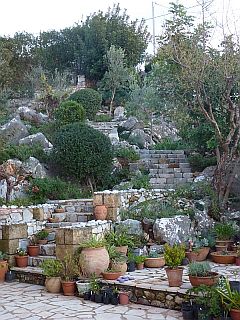
Hillside garden
(Photo Sandra Panting)
This garden was established on a relatively bare rocky hillside after the building of the owners’ house. The garden had originally been a series of terraces on which cereal crops were grown, and consequently had very little in the way of trees or other plants, though there are some enviably huge Capparis spinosa at the entrance to the garden. The predominant feature was the large rocks which are now a distinctive part of the landscaping behind the house.
There are several distinct areas, each with its own character – formal rose terraces, village-like orchard terraces with a mix of vegetables, fruit trees and flowers and, possibly the most striking feature, the ‘stairway to heaven’. This consists of a flight of steep stone steps, leading up the slope through naturalistic mediterranean planting. Selective weeding of this area allows a huge variety of wild flowers to thrive amongst the trees and shrubs – a stunning feature in spring.
In the future, a nursery area is planned, and this will facilitate the propagation of plants to supplement what is already a vast variety. The garden is irrigated - different areas receiving varying amounts of water - but the amounts are being reduced as the garden matures.
Village garden
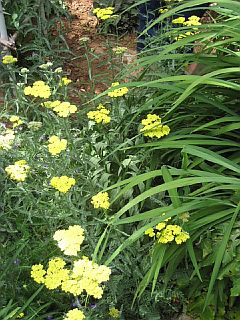
Village garden
(Photo Katerina Georgi)
The second garden was established on the site of an old mule-powered flour mill. Abandoned in the 1950s, it had become a dump for the locals' rubbish, which had to be cleared before work could begin.
The garden is enclosed by high stone walls, and a substantial buttressed stone arch, part of the original building, now forms the entrance to the garden. The area where the mill stones were now forms the central feature, and together these architectural remnants provide shelter and shade, enabling a variety of plants to thrive and giving the garden a unique character. Herbaceous plants surround the millstones, Trachelospermum jasminoides thrives on a warm stone wall, Ceanothus thyrsiflorus basks in a sheltered corner and, beyond the walled garden, is a small orchard.
Seaside garden
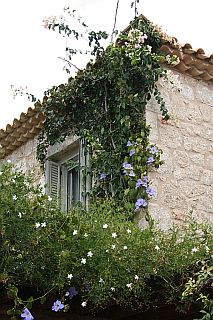
Seaside garden
(Photo Katerina Georgi)
The third garden is set on a plot next to the sea, in what was an old olive grove, though little evidence survived the building of the house. The garden is built on underlying rock and, though soil was imported, it is very sandy. Consequently, a great deal of effort goes into making compost, and this is gradually being added to the soil to improve the quality.
A network of paved paths weave around the garden and link the different areas. The canopy covering a large seating area, strategically positioned to take advantage of the stunning sea view, provides an ideal framework for the striking mauve/blue trumpet flowers of Thunbergia grandiflora whichscrambles over the pergola and up the back wall of the house, mingling with Bougainvillea and jasmine. A striking specimen of Solandra grandiflora cloaks a sunny side wall, its glossy leaves contrasting handsomely with the stone walls of the house.
There is an extensive watering system, but the intention is to reduce the amount of watering drastically, not least because the mains water is slightly saline.
At the lowest point of the garden is a natural swimming pond - these have been common in Austria and Germany for over a quarter of a century but have been hitherto unknown in Greece. The water is kept clear by mineral filters and oxygenating plants established in planting zones around the swimming area, and the pool is a haven for birds and insects.
Garden on a promontory
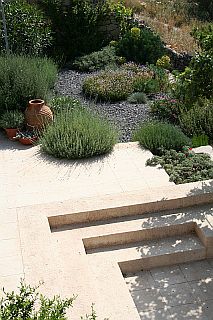
Promontory garden
(Photo Katerina Georgi)
The final garden is set on a rocky promontory, 200m above sea level, overlooking the coast. It consists of a series of flat terraces enclosed by drystone walls. Exposed bedrock predominated on the upper levels, around the house, so excavated sandstone spoil was distributed on top of this. A further layer of gravel was spread on top to create new terraces and planting areas, while keeping some of the original rock exposed.
Formal paved areas are juxtaposed with informal Mediterranean planting in gravel, and a stepped ramp leads down to the vegetable garden. From the entrance, a series of amphitheatrical steps lead to the swimming pool which, though resembling a conventional pool, is nevertheless filtered naturally, without the use of chemicals, and is possibly the first of its kind in Greece. The lowest terrace, planted with olive trees, has an old threshing floor, hewn out of solid bedrock. This was restored, stone steps were constructed on either side and wild flowers allowed to establish in the rock fissures.
The planting consists of a limited palette of Mediterranean plants. The emphasis is on structural planting, with key plants repeated throughout the garden to give continuity. An important criterion is growth habit – specifically the plants’ ability to spread and soften the edges of the hard landscaping. On the western side of the house the original terraces have been planted naturalistically to create a wild area blending with the view beyond.
Rainwater is collected from the roof of the house by means of guttering and stored in an underground cistern equipped with a pump, providing a back-up supply for occasional deep watering during the summer months.
Sadly, the weather was not very conducive to a picnic lunch, having rained heavily during the course of the morning, but we re-convened later that evening at a local taverna for illustrated talks by John Fielding and Melvyn Jope, followed by another excellent meal.
Day 3 – Trip south to Areopoli and Harouda
The day started early with a violent thunderstorm accompanied by torrential rain and hail - not the ideal start for a day’s botanising! But by 9 o’clock it was dry and, together with our visiting experts, John Fielding and Melvyn Jope, we were all on the coach heading south from Stoupa.
The first stop was near Saxoneika, on the border of Messinia and Lakonia, just south of Agios Nikon. We scrambled up a loose stony track heading east towards Agios Nikon monastery, 850m above us. Fortunately, the main plant we had come to see, Crocus goulimyi, was only 50m above the road. In spite of the storm, there were masses of C. goulimyi in its lilac form, but the scent was faint, perhaps because of the weak sun. Remarkably, the bulb of this crocus can be half a metre below ground level, finding its way up through stone walls. The more enterprising of the party found a fine example of Arum maculatum (syn. A. vulgare) with a 7 cm flower, and clumps of Teucrium polium.
After passing Oitylo, on the descent to the coast, we stopped to take in the impressive view of Limeni bay and across to Kelefa castle, but the sea lacked its usual turquoise colour, and the dramatic waves were clear evidence of the previous night’s storm.
We continued to Areopoli, where we stopped for coffee and a chance to explore the old town. Areopoli has many fine examples of the local stone-built architecture, much of it recently restored, and a little curiosity reveals fascinating shop interiors (of a type rapidly disappearing), courtyard gardens brimming with foliage, a good bookshop specialising in local literature and several superb bakeries selling local produce - ideal for our picnic lunch.
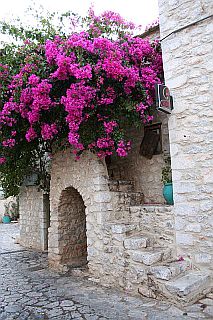
Bougainvillea at Areopoli
(Photo Katerina Georgi)
The rain started again in Areopoli, but had ceased by the time we arrived at our next stop. Here we saw good examples of Crocus niveus in both its blue and white forms and Colchicum pusillum. A seedling of Astragalus made a lovely composition with a clump of C. niveus. John pointed out how to distinguish Euphorbia acanthothamnos from Sarcopoterium spinosum (thorny burnet), simple when the plants are in leaf following the autumn rains, but not so easy during their summer dormancy. In spring, Lilium candidum and Serapias species can also be found in this area.
From our next stop, Triandafilia, we set off on a 2km walk to see Sternbergia lutea in the village of Harouda, the road being too narrow for our coach. The wiser members of the group looked at the approaching squall and stayed with the coach; our gung-ho leaders led us into a torrential downpour which drenched trousers and filled boots - one member was tempted to put on her bikini. Having battled with the elements, we made it to the beautiful 11th/12th-century church of the Taxiarch, by which time the sun had emerged, and we were able to dry out over picnic lunch in the walled churchyard, which now resembled a Chinese laundry – damp, steaming clothes draped everywhere.
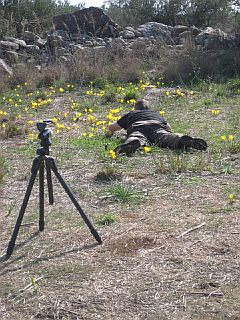
Prostrate photographer and Sternbergia lutea
(Photo Katerina Georgi)
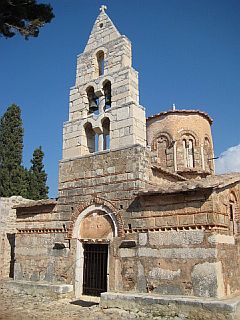
Church of the Taxiarch, Harouda
(Photo Katerina Georgi)
The Sternbergia around the church were astounding in their quantity; their glorious yellow colour led to covetous thoughts of returning in April to collect seed, which germinates readily and quickly produces flowering plants. In some parts the Sternbergia were accompanied by an Iris species not in flower: probably garden escapees of Iris x germanica (also called I. florentina). In the centre of the village was an interesting walled garden with superb mulberry trees, pruned into a spreading habit to provide shade in summer and, flourishing beneath them, a surprising emerald green alternative lawn. Sadly, the surrounding olive groves had been devastated by fire in May, but nevertheless the Cyclamen were flourishing in the bare fields.
Harouda marked the end of our journey south, and from there we headed back to warm showers and dry clothing, followed by the group’s last meal together at a Kardamyli taverna. The drive was accompanied by wonderful views of late afternoon light, with clouds over the mountains and a spectacular rainbow below us, comprising almost two thirds of a circle. A truly splendid day.
Text contributed by Chris and Graham Aveyard, Katerina Georgi and Richard Robinson
May 2013
Exploring the Parnon mountains
Twenty members of the Peloponnese group took part in a three-day trip to the Parnon mountains at the end of May, staying in the remote village of Tsintzina (also known as Polydroso).
Day 1
The group met in Skala and drove in convoy to Paleomonastiro, near Vrondomas, enjoying vistas of both the Taygetos and Parnon mountains en route. Built into the cliff face of a gorge on the river Evrotas, the monastery is dedicated to the Panagia (Holy Virgin) and Saint Nicetas. It was the site of a tragic occurrence in 1825 when local villagers, sheltering there from persecution by Ibrahim Pasha, were betrayed and martyred when the building was set alight. However, many beautiful frescoes, some dating back to the late 12th century, have survived. On the opposite side of the gorge, the caves that previously served as a leper colony were visible. Beside the path leading down to the monastery, bright yellow broom, cistus, pale pink bindweed, scabious, thyme, and blue cupidone (Catananche caerulea) were all in flower.
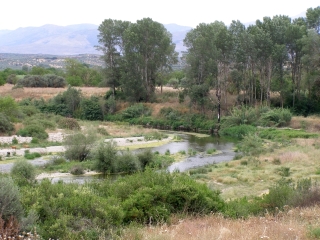
The Evrotas river
We picnicked bedside the fast-flowing waters of the Evrotas, the river that some believe was used by Paris in his abduction of Helen of Troy from Sparta. From there we moved on to the village of Kalithea, with its two huge Platanus orientalis trees shading the square. After liquid refreshment, some drove and others walked to the nearby ruined Frankish/Venetian castle. Euphorbia rigida, several shades of cistus, and many blue larkspurs edged the route. Abundant clumps of thyme were frequented by bees from nearby hives. Despite the hazy atmosphere, the views from the castle were breathtaking, particularly looking towards the Taygetos mountains.
Our journey continued northwards, climbing through what had been a vast area of pine forest, now sadly depleted by extensive fire damage in 2007. The vegetation was mostly scrub until walnut trees appeared as we approached Tsintzina. From our hotel on the upper outskirts we had delightful views of the village nestling in the forest below us. The day was rounded off with an excellent group meal in the hotel.
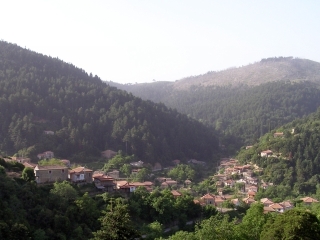
Tsintzina in the early morning
Day 2
On the second day the party split into two – one group undertaking a challenging climb up through the pine forests to a height of 1600m, and the second group taking the gentler option of exploring the mountains by car.
The ‘challenging’ option
The tougher option took us on a circular walk along a well-marked route through forest consisting predominantly of Aleppo pine (Pinus halepensis) and Greek fir (Abies cephalonica). We climbed about 400 metres through very different terrains including dirt tracks and a dry river-bed leading to a plateau and meadow land, finally descending on a steep goat track.
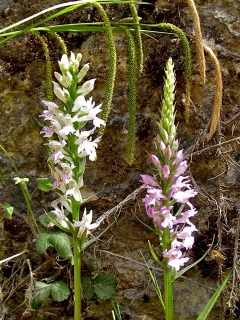
Dactylorhiza saccifera
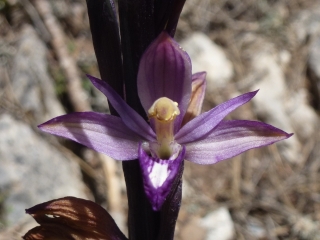
Limodorum abortivum (violet bird’s-nest orchid)
Photo by Sandra Panting
There was plenty to see during our ascent, including Hypericum olympicum, Sedum laconicum, Centaurea raphanina, Astragalus angustifolius, and several (tentatively identified) species of orchid. Our most exotic find was a daisy-like yellow flower with an almost globular calyx, identified as Hymenonema laconicum, which is endemic to the Peloponnese. We picnicked on the plateau, and were rewarded for our climb by finding and picking from a plentiful supply of mountain tea, most probably Sideritis clandestina (again endemic to the Peloponnese), which grows above 1000m. There were also a few remaining cyclamen and some thrift in both pink and white (Armeria canescens?). The main meadow on the plateau had been mown recently and was occupied by a large number of beehives – the drone of the bees was almost deafening – but some bright pink sweet peas had survived.
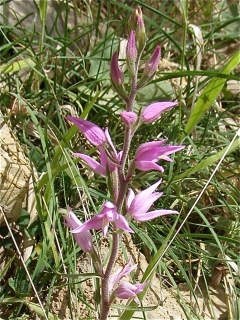
Cephalanthera rubra (red helleborine)
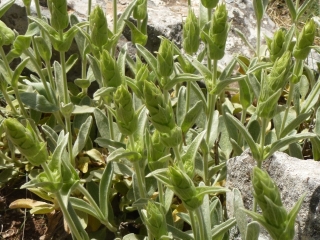
Sideritis clandestina
Photo by Sandra Panting
The ‘easy’ option
Meanwhile, the ‘gentle folk’ set off by car to explore the heights of the Parnon mountain range. Climbing to a height of 1610m through the forest, our first stop was at the ‘top of the world’, the small church of Agios Ioannis. From there, on a clear day, one can see the bay of Nafplion as well as the Laconian gulf and the ever-beautiful Profitis Ilias in Taygetos. Nearby there was an abundance of Euphorbia rigida with its orange/rust-coloured bracts. We also saw aubretia, and an interesting cluster of Astragalus tragacantha (syn. A. massiliensis). Aside from the lovely white blossoms, it was full of butterflies. Along the way we passed many thistle-type plants, probably Onopordum laconicum.
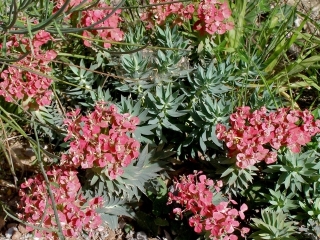
Euphorbia rigida
Our second stop, where we ate our picnic, was at a refuge at 1420m, called in Greek Katafigio ‘gamma’, Papatheodorou. On the shady side of the refuge was a lovely cluster of snow-in-summer (Cerastium tomentosum). In an alpine meadow nearby we found two types of poppies still blooming: the orange-coloured Papaver argemone and the larger, deep red Papaver apulum. Scattered along the way were star of Bethlehem (Ornithogalum umbellatum) and Potentilla hirta with its attractive yellow flower and furry leaves.
Early evening
We were fortunate to be invited into the village home and garden of N and his wife G. N showed us around his steeply terraced garden, describing his approach to growing vegetables. Everything possible from the house and garden is composted and used to feed the soil each spring before N plants his tomatoes, courgettes and cucumbers. He uses a combination of weed-suppressing membrane and a drip irrigation system to reduce the workload. G then showed us around the inside of their beautifully restored but still very traditional village house.
While we enjoyed refreshments, N told us about his childhood in Tsintzina and about the movement of villagers between the ‘binary’ villages of Tsintzina and Goritsa. Tsintzina is the higher village and was occupied in the summer, but winter temperatures there are generally ten degrees lower than in Sparta, so the villagers withdrew to Goritsa. However, Goritsa became almost uninhabitable during the summer due to mosquitoes and malaria, so the villagers, at that time numbering some 1000, walked the 30km trail between the two villages across the mountains twice a year. As there was no shade along the kalderimi, they travelled at night by the light of the full moon, taking with them all their animals and possessions. The smaller children were tied to the backs of the mules to prevent them from falling off when they inevitably fell asleep.
Tsintzina is still largely uninhabited from October to June, which became obvious to us when we walked down into the quiet village for a group meal in a traditional and very hospitable taverna.
Day 3
Once again there were two options. A small group set out to walk to the remote village of Kaloni where local member Kjeld lives. Meanwhile, the larger group went on a gentler walk in the upper meadows.
The ‘challenging’ option
We were to walk about a third of the trail linking Tsintzina and Goritsa, heading mostly downhill towards Goritsa along a former kalderimi and then striking off towards Kaloni. The local landscape was interesting for what it told us about its past and its evolution. About 10,000 years ago this area, in common with much of Greece, was clad predominantly in Quercus ilex, the holm oak. Due to deforestation and over-grazing, it now supports only steppe-like vegetation – a shrub layer at the maquis level, giving way to phrygana species, chiefly Quercus coccifera, the evergreen kermes oak. Here the oak has not been able to regenerate following damage by fire and grazing goats, so now it can only form a shrub. Interspersed were some other small trees, notably Acer sempervirens and a couple of beautiful Arbutus andrachne. Lower down were spurges and then the cultivated belt of olive.

Peeling bark of arbutus
Some five weeks previously, when this route was waymarked, there were, in glorious flower, Jerusalem sage (Phlomis fruticosa), Cistus incanus and the more plentiful Cistus salviifolius, Trifolium brutium (syn. T. aurantiacum), many sedums and rock-clinging plants, and the beautiful, but highly toxic, Globularia alypum. Now, sadly, little remained but shattered seed heads, desiccated thistles, tall silvery grasses and Thymbra capitata (syn. Thymus capitatus).
When we eventually left the kalderimi and crossed the valley to Kaloni, Kjeld's stone house was a cool haven and his cold refreshments very much appreciated.
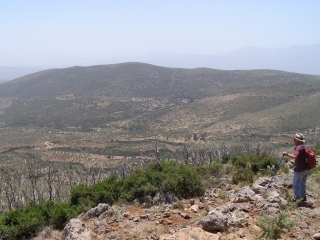
The kalderimi, with Kaloni just visible in the centre of the picture
The ‘easy’ option
The gentle walk began with a quick uphill march, to put distance between us and the bees that were foraging close to the road. The slope flattened out into a meadow where we gathered plant specimens to examine later in the day. There was a good variety of plants still in flower. Growing in the shade of trees were clumps of snow-in-summer, Cerastium tomentosum, familiar to many of us from our rockeries in northern climes. We spotted three different types of convolvulus, the pink bindweed Convolvulus cantabricus, the mallow-leaved bindweed, C. altheoides, and a pretty pink and white striped bindweed, C. arvensis. We were delighted to find Hymenonema laconicum, which, although rare, was plentiful in the meadow.
Some of the surrounding Greek firs had perished in a fire, but those that survived were sprouting bright green candle-like growth at the ends of their branches. There was a bush heavy with blossom that exuded a scent reminiscent of hawthorn, but the flowers were a creamy colour and the leaves were much smaller than those of the English hedgerow tree.
Back in our vehicles, we made for Kaloni where we cooled down on Kjeld’s veranda with cold beers and enjoyed our picnics. In the garden we admired the hard landscaping and pergolas, which made a harmonious and practical framework for the plants, including stunning purple clematis in full bloom. In Kjeld’s sitting-room was a continuous slide show of his photographs of wild flowers, butterflies, and fascinating close-ups of greenfly.
Illustrated talk by Kjeld Kjeldsen on plant physiology
When the hardier group had arrived and been refreshed, Kjeld gave a talk on plant physiology. He began by illustrating the ratio between the various gases that constitute the air, and showed how these proportions have varied through the millennia. Volcanic activity was and is an important factor in these shifts, increasing the amount of carbon in the atmosphere and causing changes in climate. These changes have radically affected life on Earth, at one time instigating an era of trees forty metres high and centipedes two metres long, and at others at least five instances of mass extinction. Life forms adapted to changed atmospheric conditions and survived; if they did not adapt, they perished. With carbon particles in the atmosphere now reaching more than 400 parts per million, exceeding the amount that experts in climate change consider safe, what will happen next?
It was against this ecological background that Kjeld focused on the physiology of plants, especially the leaves and their stomata. These are microscopic openings through which gases are exchanged, allowing carbon dioxide to be absorbed from the atmosphere and oxygen and water vapour to escape. The role of the stomata is thus crucial to plants – and to the air we breathe. Via a powerful microscope connected to a large screen, Kjeld displayed a blade of grass. At a magnification of 50x, the dumbbell-shaped stomata became visible. The kidney-shaped openings of a basil leaf were detectable at much lower magnification and it was apparent that the density of stomata in basil is much greater than in grass. Now we know why basil is a much thirstier plant than grass.
The group was then invited to use Kjeld’s microscopes to examine the plant specimens collected earlier that day. Gasps of wonder were audible from those not accustomed to seeing living things in such minute detail. Examining the Hymenonema laconicum was particularly rewarding. The contours and shapes of the constituent parts of the flower were clear and the colours sensational. Portrayed in golden yellow and drab brown in the reference books, in real life there was more than one shade of yellow in the petals, the base of the corolla was bright magenta, and the ends of the stamens were a contrasting sulphurous yellow.
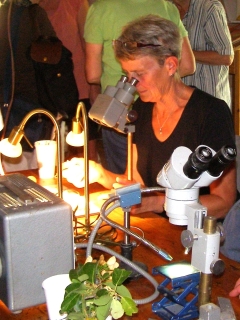
Using Kjeld’s microscopes
It was a unique and spectacular ending to a well-planned, enlightening and thoroughly enjoyable three days. A warm vote of thanks was given to the organisers, Kay Elvina-Sutton assisted by Kjeld Kjeldsen and Dennis and Barbara Balfour; Kjeld was also thanked for his generous hospitality and for passing on to us his enthusiasm for the fascinating world of the very small.
Text contributed by Mary Hayes, John Karaiossifoglou, Tracy Kyriakeas, Barbara Balfour and Lilian Munby.
Photographs by Linda Reynolds except where indicated.
October 2012
A cyclamen walk with Melvyn Jope
Where could you go for the opportunity to learn to identify cyclamen with a recognised expert on Greek cyclamen species, look at frescoes in Byzantine chapels and churches, watch candle-making and encounter conversations about electron microscopes and asteroids? Such was the nature of this walk with the MGS Peloponnese Group. The cloud and rain of last year’s abandoned cyclamen walk were a distant memory as members of the group met in the sun-bathed square in Milia, beneath the tower of the Church of the Metamorphosis. The village nestles in the mountains at about 500m above sea level. The outing was led by Melvyn Jope and comprised three separate walks. We were also joined by Alexios Vardakis from Athens University.
The first short walk took us west on the road towards Platsa. Along the road we saw some small specimens of cyclamen, but not enough really to draw our attention. Melvyn confirmed the identification of a Clematis cirrhosa, but we were collectively unable to identify a small white-flowered plant. Near the road was an interesting vegetable plot with courgette plants growing up through the trees and in the prime of their flowering. Euphorbia was also seen growing on the roadside, and we were reminded by Melvyn of the unpleasant effects the sap of this plant can have on the skin. After a short distance we turned down a well-maintained path to the church of St John the Baptist, Agios Ioannis Prodromos, which will forever be known among certain members of the group as the ‘seventeen-ounce church’ due to the peculiar carving of the date 1702 above the door. The path had Cyclamen hederifolium ssp. crassifolium and Crocus boryi growing between the stones. We also had a view across the valley with the sun catching Kato Hora, which we were to visit later.
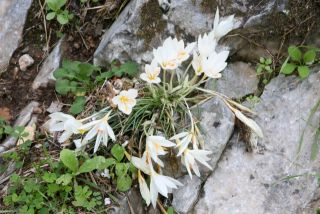
Crocus boryi
The courtyard of the church was humming with the sound of bees in the ivy covering the surrounding walls. The key was retrieved from its hiding place and we were able to enjoy the beautiful frescoes painted in 1706 by Christodoulos Kalliergi of Mykonos. We then continued past the church down part of the old kalderimi, which held the promise of even more flowers in the spring. Our leaders were hoping for evidence of Galanthus, but the prolonged hot weather seemed to have delayed their emergence: not even a leaf was found. As the undergrowth thickened, and not being sure of where the path would emerge, we returned the way we had come. Back on the tarmac road into the village, a few members at the head of the group spotted a recycling opportunity: next to the bins was a collection of ‘bottomless’ chairs. These quickly disappeared into the backs of cars and even on to the pillion of a certain member’s motorbike, who later somehow cunningly managed to negotiate an exchange for an intact chair at the taverna. We look forward to a spring display of some members’ efforts at seat-weaving during the winter evenings.
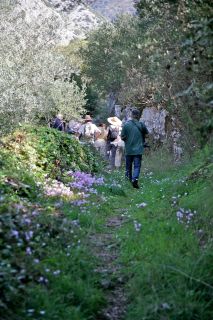
The path through the olive groves
We then set off out of the village again on our second walk, this time heading east along the path, which eventually, after a 500m ascent, leads to the Panagia Giatrissa Monastery, seen on the ridge in the distance. Ours was a gentle walk through peaceful olive groves, where part of the footpath to a small stone bridge was an avenue of cyclamen. These were mainly Cyclamen hederifolium ssp. crassifolium; Cyclamen graecum with its wonderful leaf forms was also found.
On the steps of the little chapel just beyond the bridge, Melvyn displayed some specimens, showing the differences between Cyclamen hederifolium ssp. crassifolium (on the left of the photograph) and Cyclamen graecum. The booklet The Cyclamen of Greece, co-authored by Melvyn Jope and Peter Moore (published in 2011 by the Cyclamen Society, London, ISBN 978-0-9537526-3-8 and reviewed in TMG 68), is an excellent guide to the species of cyclamen growing in Greece, and invaluable in assisting with identification.
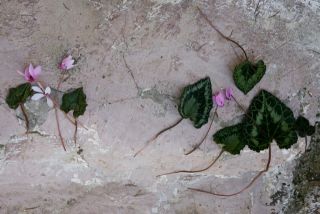
Comparing cyclamen species
Returning by the same path with views back to Milia, one keen-eyed member spotted a small red fungus, Clathrus ruber; Melvyn had shown a slide of this species during his talk the previous evening. Below it, at the foot of the wall, was a larger, more sinister-looking fungal specimen. Other plant species seen on the walk included Mirabilis jalapa, Allium callimischon, Spiranthes spiralis, Prospero autumnale (formerly Scilla autumnalis) and Datura stramonium. We also saw species of ferns, including Asplenium trichomanes. On the way back, some conversations strayed from flowers to electron microscopes and to asteroids narrowly missing the Earth.
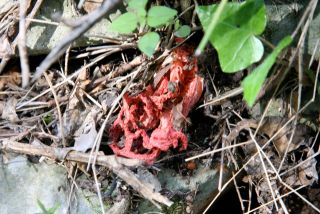
Clathrus ruber
Following a picnic lunch in the sunny Milia square, we shared cars to drive to the square in Kato Hora on the north side of the valley for our third expedition. The church of Agios Nikolaos was opened for us by Niko, who has returned from the USA to his home village and now maintains some 12 or so churches in the area, and he is developing a small museum in the village. The magnificent frescoes, dating from 1749, cover the inside of the church and are in the process of being restored, using original natural pigments. Outside again, we dropped down into the upper part of the Tepeni Gorge, where we were rewarded by a specimen of rare white Cyclamen hederifolium ssp. crassifolium f. albiflorum.
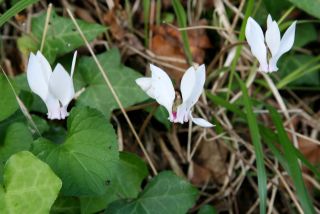
Cyclamen hederifolium ssp. crassifolium f. albiflorum
This is another area rich in Galanthus, but there was no evidence of them emerging yet. We returned to the square via another steep stone path. While waiting for the rest of the group, some members were admiring the display of flowers up the steps of one building and growing through the railings above. A strange passion flower nearly had us fooled, but on closer inspection through binoculars, it proved to be a specimen cunningly intertwined with fabric flowers.
We completed our tour by being shown the fledgling museum opened by Niko, with many old photographs of villagers, including Niko as a young man. (For more information about Niko and his life, see Inside the Mani magazine 2012.) Niko also demonstrated the traditional method of candle-making by running hot wax down the wicks. Making 5000 candles for name-day celebrations takes several weeks.
A short drive back to the taverna in Milia, which opened especially for us, completed a thoroughly enjoyable day in good company, with beer, frappé, more cake and good conversation. Our hosts also joined in with some wonderful biscuit treats. Thank you to Martin and Jeswyn for organising another very interesting day, to Sandra for the delicious cakes, and to Melvyn for leading the group and answering all our many questions and queries.
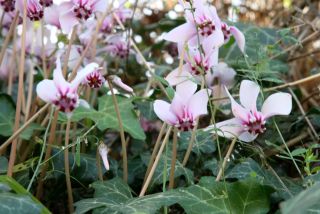
Cyclamen hederifolium
Text by Chris and Graham Aveyard
Photos by Graham Aveyard
October 2012
Spring and Autumn in the Peloponnese: an illustrated talk by Melvyn Jope
As most members will know, there is an MGS Forum where we can post questions – and answers – concerning plants and gardens. A little while ago, a member used the Forum to ask if anyone could identify the species of cyclamen growing in her hillside garden at Neohori, West Mani. The most helpful response came from no less an expert than Melvyn Jope, who has studied cyclamen (and snowdrops) for many years. Melvyn modestly describes himself as an enthusiastic amateur, but in fact he is at the cutting edge of field research. He has for some years been chairman of the Cyclamen Society in England, which is the International Registration Authority for cultivars of all the cyclamen species except Cyclamen persicum. The organisation is affiliated to the Royal Horticultural Society.
This response through the Forum led to an invitation for Melvyn Jope to give a talk to the Peloponnese Group of the MGS, and next day to lead a walk in the locality of Milia to look at the autumn flora, with the focus on cyclamen. The venue for Melvyn's talk (and dinner afterwards) was a taverna in Stoupa, and from here he took us on a colourful tour of the Peloponnese with his magnificent photographs. Melvyn’s great love for Greece – and for botany – was immediately obvious. His pictures of people, places and plants captured vividly what it is to travel in this area with eyes (and mind) open. Some of the photographs you could almost smell. Intentionally out-of-focus faces inside Nafplion’s Orthodox church during the midnight ceremony at Easter evoked the aroma of incense. In a mountainous landscape a definitely fragrant young goat-herdess, crook in hand, smiles radiantly into the camera, while her 500 or so not-so-fragrant goats mill about in the meadow beyond. As for the places depicted, one area which seems especially dear to Melvyn's heart is around Agios Petros in the northernmost part of the Parnon range, where Cyclamen rhodium abound. Some of us had encountered C. rhodium ssp. peloponnesiacum on an earlier expedition into the foothills of the Taygetos, but would love to see it in a different landscape, with the bonus of finding it alongside a subspecies we did not see on that earlier occasion – C. rhodium ssp. vividum.
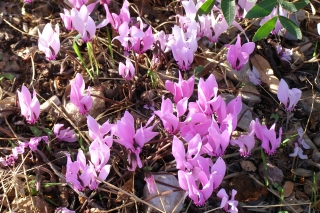
Autumn cyclamen in profusion
Such evocative pictures of people and places were interspersed with studies of spring and autumn plants. The focus was on the six species of cyclamen that grow wild in Greece and the characteristics by which each specimen may be identified. Our attention was drawn to the different environments they inhabit – some prefer red soils, others limestone or leaf litter, some like shady places and others tolerate more sun. The tubers (when you can see them) have varying textures. They produce roots and stems from the centre or from one side, depending on the species. Leaves, too, have different textures: velvety, silky, fleshy or shiny, according to their species. Those of Cyclamen hederifolium ssp. crassifolium are characteristically glossy. The shapes, colours and patterning vary between species, those of C. hederifolium var. hederifolium being the most variable in colour and patterning (and perhaps the most beautiful), although the leaf shape is more consistent. Some species are perfumed, others not. All cyclamen flowers have reflexed petals, but colour and markings vary, as does the shape – some have comparatively rounded petals, and others are formed like twisted rabbits' ears. Auricles around the mouth are present in some species (e.g. C. confusum), but absent in others (e.g. C. creticum). One of the most fascinating and endearing features of cyclamen is the way in which they protect their seed pods, the stems of the fading flowers curling, then spiralling around the pod, cradling and gently drawing them down to the ground, where they are less likely to be damaged by the elements or eaten by goats.
Our speaker’s presentation appealed not only to those who were generally interested in Greek wild flowers, but also to those with specialised scientific knowledge. If you wanted to know about the chromosome counts at Kew or DNA studies of cyclamen at the University of Reading, the information was there. Or you could simply sit back, look at the beautiful photographs, and absorb some of the warm enthusiasm underlying all Melvyn had to show and say.
For those who are intrigued and want to know more about this remarkable flower, I strongly recommend the little book of which Melvyn Jope is co-author. It is clearly written, thoroughly readable and informative, and beautifully illustrated with photographs. On the last page there is a simple map of Greece showing in which provinces and on which islands the various species can be found. The book is called The Cyclamen of Greece, by Peter Moore and Melvyn Jope, published in 2011 by the Cyclamen Society, London, ISBN 978-0-9537526-3-8. It was reviewed in TMG 68, April 2012.
One of the aims of the Cyclamen Society is to disseminate and extend knowledge of the genus Cyclamen and its species. Melvyn has certainly achieved that end, and, moreover, his achievement will endure because he infected us with his personal enthusiasm for this distinctive and beautiful product of nature. Our grateful thanks go to him, and also to Sandra Panting, whose question to the MGS Forum provoked it all.
Lilian Munby
Photo by Linda Reynolds
October 2012
Peloponnese Group – Walk from Kardamyli to Agia Sofia for a garden visit
On a sunny and warm autumn morning, members of the Peloponnese group set out to walk from Kardamyli to re-visit Katerina Georgi’s garden, well over a year having passed since the previous MGS visit (see May 2011, Visit to four gardens in the Kardamyli/Stoupa area). Our route took us through the old town of Kardamyli, currently undergoing restoration works, and thence via a kalderimi (ancient paved donkey track) to the little church of Agia Sofia and Katerina’s home. The vegetation along the way consisted mainly of lentisc, kermes oak, phlomis and cistus, with some fine specimens of carob providing welcome shade here and there. Wild mint and cyclamen were common along the edges of the kalderimi and there was the occasional tiny teucrium between the paving stones. An interesting find was Lithodora zahnii, an endemic that has blue and mauve/pink flowers in the spring but blooms only to the south of Kalamata. Nearby, Smilax aspera was winding its way through a lentisc.
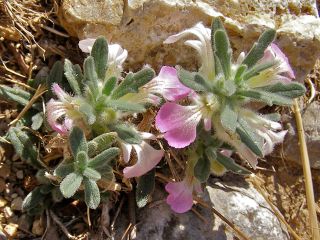
A tiny teucrium growing in the path
(Photo by Linda Reynolds)
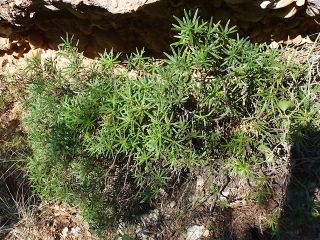
Lithodora zahnii
(Photo by Sandra Panting)
Three quarters of an hour’s warming uphill effort brought us to Agia Sofia, with its dramatic views of the hillside and the sea below. Nearby, welcome refreshments awaited us at Katerina’s beautifully restored house, where modern design and materials are in harmony with the original traditional stone building. The entrance to the garden gives on to a pathway of magnificent stone slabs set into gravel, leading to the house. On either side are areas of hard landscaping at several different levels. The levels were either determined by areas of flat rock around the house, or created to accommodate spoil from building works. Concrete surfaces have been dressed to create a natural look, and sympathetic planting has softened the edges of the hard landscaping. There are several seating areas at different levels within the garden. Further away from the house is an olive grove in its natural state and an old aloni (threshing floor).

Planting in the raised beds is growing well
(Photo by Linda Reynolds)
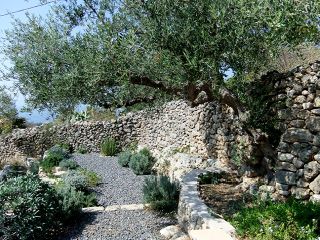
The garden blends into the surrounding landscape
(Photo by Linda Reynolds)
The garden is approximately 200 metres above sea level, predominantly south-facing, and with soils developed from the underlying sandstone. The original planting included some 90 species selected for their drought resistance, their leaf texture and the way they associate with other plants. Among Katerina’s choices were oleander, rosemary, echium, phlomis, spurge, scented geranium and artemisia, with particular emphasis on evergreens to give year-round interest. October colour was provided by the purple flowers of Lycianthes rantonnetii (formerly Solanum rantonnetii), the brilliant blue of Ceratostigma plumbaginoides, the more subdued blues of Plumbago capensis and Felicia amelloides (blue marguerite), the mauve of Tulbaghia violacea, and the magenta of a low-growing bougainvillea (Bougainvillea glabra). The white flowers of Cestrum nocturnum (night jessamine) were in bud, preparing to scent the autumn evening air. The extent to which the planting had grown and encroached on the edges of the hard landscaping since the previous visit was very noticeable, creating a garden that perfectly complements the lines of the house and at the same time is in tune with the surrounding countryside. Although this is a waterwise garden, new plants needed watering from time to time to survive this year’s hot, dry summer. For this purpose, rainwater is collected from the roof of the house and held in an underground tank.
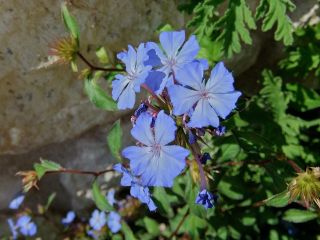
Ceratostigma plumbaginoides
(Photo by Linda Reynolds)
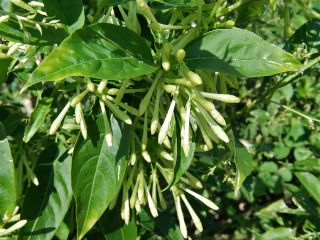
Cestrum nocturnum
(Photo by Linda Reynolds)
Our return route to Kardamyli took us on a steep path down to the river bed, where cyclamen were in bloom, up towards the hamlet of Petrovouni and back to Kardamyli on the kalderimi. Along the way were the orchid Spiranthes spiralis (autumn ladies’ tresses) with its marzipan scent, Prospero autumnale (syn. Scilla autumnalis, autumn squill) and, between the stones of the kalderimi, the occasional Narcissus obsoletus and Colchicum boissieri.
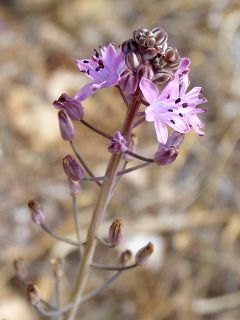
Prospero autumnale
(Photo by Linda Reynolds)
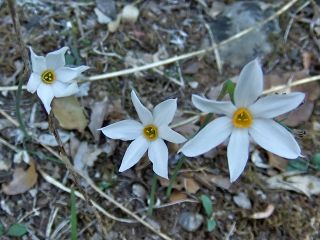
Narcissus obsoletus
(Photo by Linda Reynolds)
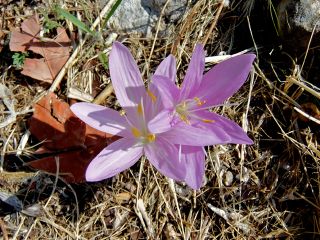
Colchicum boissieri
(Photo by Linda Reynolds)
A delightful walk and a varied and interesting morning concluded with a late meze lunch at an excellent beach taverna, where we were able to slake our thirst and even take a refreshing dip in the sea.
Linda Reynolds
May 2012
A garden in Sparta and a walk in the Taygetos
The garden of Ada Kopitopoulou, who lives in Sparta, was the meeting point for 21 members of the Peloponnese group. Ada had very kindly made all the arrangements for this event. She began by serving coffee and cakes in her garden, creating a welcoming and friendly atmosphere that set the mood for the day.
Ada lives in a street where all house fronts are lined up along the pavement. This means that any visitor turning off the pavement and walking through the gate to the garden at the back is in for a wonderful surprise. The garden is like a secret haven, where flowers, flowering bushes and shrubs live in close harmony, holding hands as it were. Ada has a knack of training them to intertwine with one another, locked in such an embrace that geraniums poke their heads through the foliage of jasmine and clematis sit in the lap of roses, heads turning to face the sunshine together.
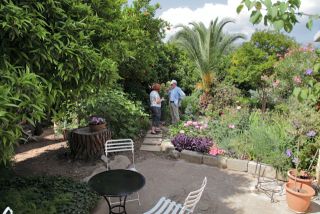
Ada’s garden.
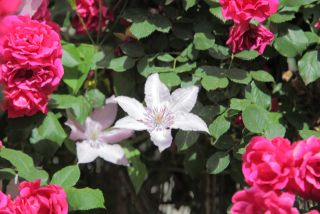
Clematis and roses.
The garden is arranged in islands of flowering plants with natural paths meandering around them. There was soon a buzz of activity: not the insect kind, but the human kind. People were milling around, tea and cake in hand, talking about what they saw, and drawing others’ attention to the many surprises, especially the beautiful, bright red abutilon occupying pride of place, a worthy focal point that generated lots of conversation. Other notable blooms were clematis, euphorbia, dahlias and verbena. And then, of course, the vegetable garden with the season’s greens, courgettes, tomatoes, beans and luscious strawberries ripe for picking. Ada was able to provide lots of information about the plants we saw.
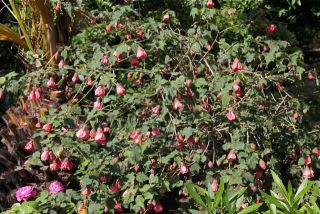
The red abutilon.
Then we all drove off in convoy to Mystras, where we stopped to check our numbers before taking the long winding road that climbs steeply up the lower slopes of Mount Taygetos to Taygetos village, unknown territory for most of us. The convoy drove through the village and pulled up outside the Taygetos Summer Camp and the imposing but closed gates of the seventeenth-century monastery of Zoodochos Pigi, the starting point for our walk. Ina Van Delden led us (sunhats on some heads) as we climbed above the camp and into the rolling hills, where we were welcomed by a cheerful but elusive cuckoo that kept us company for much of the way. The snow-covered ridge of this central part of the Taygetos range soon came into view, some 600 metres above us.
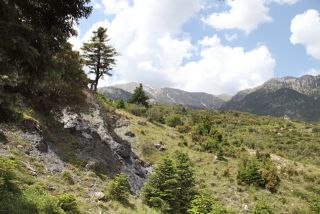
The green slopes of the central Taygetos.
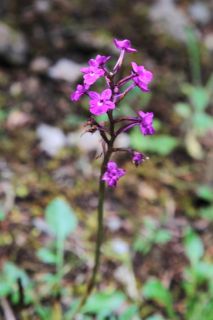
Orchis quadripunctata.
As always in the countryside of the Peloponnese, walkers are torn between two different kinds of beauty: the majestic beauty of the great mountain scenery that never ceases to amaze, and beauty in the small that stands at your feet and can so easily be missed. This was the beauty we were in search of and we were not disappointed, as there, snuggling beneath fir trees and along the edges of the footpath, were orchids, grape hyacinths, wild lupins and cistuses. We stopped to admire and take photographs, our pace leisurely and the cuckoo still keeping us company as the path took us back down towards the camp. Then the clouds could hold out no longer, and after a few rolls of distant thunder, the first drops came down. Sunhats disappeared. Out came waterproof capes, mackintoshes, plastic hoods and even a lace-trimmed umbrella, apparently a family heirloom. But it was a gentle shower that left us refreshed and grateful, coming as it did on the last stretch of our two-hour walk.
Back in the car park at the camp we said goodbye to our cuckoo and drove down to the springs of Kefalari by Agios Ioannis village. Here we had a perfect, late lunch under the lush green canopy of centuries-old plane trees. After lunch, when the trip back home was establishing itself in our minds, Hilary produced lots of little paper bags, each containing a tiny cactus, and gave one to everybody. A lovely reminder of a perfect day.
Kay-Elvina Sutton
Photographs by Kjeld Kjeldsen
April 2012
Andritsaina
Some 25 members of the Peloponnese group made a weekend visit to Andritsaina in the mountainous region of Elis (or Ilia) on the border of Arcadia and Messenia. This small settlement played an important part in the Greek War of Independence. In 1826 it was destroyed by Ibrahim Pasha’s troops, but today it is an attractive village with substantial old stone-built mansions, cobbled streets and magnificent views. It is home to the internationally known Nikolopouleion library of rare 16th and 17th century manuscripts in Greek and other languages, and it also has a remarkable folk museum.
Our hosts, Carolyn and Nassos Goutis, had planned an interesting programme for us, and as always Martin and Jeswyn Jones were there to keep us in order and make sure we enjoyed ourselves. The local people were friendly and hospitable and went out of their way to make us feel welcome. One taverna was so small that a long table had to be placed diagonally across the room to fit us all in. The food was delicious and even the most pernickety guest was catered for with good will.
On the Saturday morning the folk museum opened up specially to fit in with our schedule. This was possibly the best museum of its kind that many of us had visited. The upper storey was devoted mainly to handicrafts and costumes. Exquisite embroidery on various textiles was on display, as well as clothes dating from the early nineteen hundreds, all in amazingly pristine condition. On the walls were photographs of the family who had lived in the house, at home and on their various travels, actually wearing some of the clothes. It brought alive the life of a patrician family in Greece at that time. The lower storey of this original house was furnished as it would have been: a dining room with the table set for dinner, a kitchen with all the utensils at the ready and a bedroom with a dressing table laid out with all the beauty aids that a lady might need. All the rooms looked as if they had been left only a moment or two before. We all said it was well worth visiting the village just for the museum. Unfortunately, we weren’t able to gain access to the library, so this was a treat to be saved for another occasion.
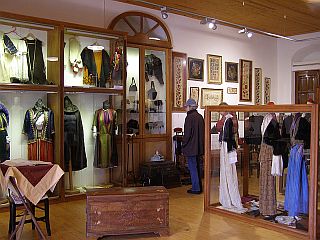
Part of the costume display in the folk museum.
After leaving the museum, we drove in convoy to the village of Kallithea, about 18km north-west of Andritsaina, where Nassos and Carolyn were waiting to take us on a circular walk. The weather was perfect, with sunshine, billowing cumulus clouds, and a breeze to keep us cool. Our route took us first in a westerly and then a southerly direction. Looking north over the broad and cultivated Alfeios valley spread out below us, it was possible to see the tributaries Ladon and Erimanthos joining the Alfeios and, on the far horizon, the mountains beyond which Patras lies. Looking westwards towards the present-day village of Platiana, the ruins of the ancient acropolis of Aipy, one of the oldest fortified cities in the region of Elis, could be seen in the distance. Between the hills in the direction of Katakolo and Pirgos, and looking a little further south towards Zaharo, the sea was visible. Our attention was divided between these spectacular views and what lay at our feet. Nestling among the greenery at the edges of our path we spotted Pisum elatum, Linum hologynum, Doronicum caucasicum (a species from the same genus as leopard’s bane), Leopoldia comosa (syn. Muscari comosum), Vinca minor, the occasional Anemone coronaria, and orchids, including Anacamptis coriophora (bug orchid, syn. Orchis coriophora) and the gorgeous Orchis simia (monkey orchid). Also along our way were plentiful examples of Cercis siliquastrum, Genista fasselata (syn. G. sphacelata), Lupinus albus and some fine specimens of Erica arborea. Turning northwards and eastwards on the return leg of our walk, we found a sheltered spot beside the path for our picnic lunch. From a nearby vantage point it was possible to make out four ancientacropolises, including Alifeira which dates back to at least 300 years BC. Returning to Kallithea and completing our circular tour, we were invited to the home of our hosts for tea and cakes.
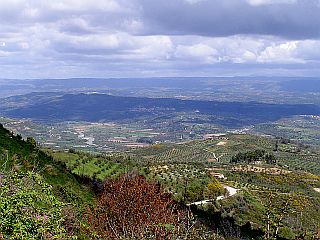
The Alfeios valley

Anacamptis coriophora (bug orchid).

Orchis simia (monkey orchid).
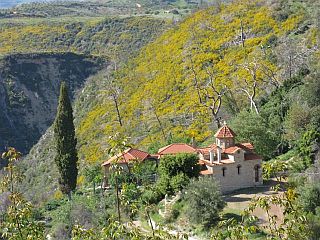
The monastery at Alifeira.
For those of us unable to complete the walk, the village offered compensations: a field of wild lupins, country gardens with flourishing vegetable plots fringed with bright orange marigolds, porches overhung with rambling roses, a meeting with a lady riding home, who apologised for not being able to offer us a lift on a her young, fluffy donkey. In these verdant surroundings only the preponderance of young saplings and stacks of sawn-up charred logs was a sad reminder of the devastating fires of 2007.
The following day began with a visit to the magnificent Vassae temple, still shrouded in a huge white tent while it undergoes essential repair work. In the surrounding ruins we wandered in a blue haze of speedwell; here and there we found Anemone blanda, some a slightly pinkish blue, some almost white. We then moved on to the ruins of ancient Figalia, where we waded through a knee-high sea of flowers, including Crepis rubra, Tordylium, Bupleurum longifolium and phlomis. Other finds included Lupinus angustifolia and the occasional Ephedra fragilis (joint pine). The morning concluded with a drive on winding mountain roads through wonderful scenery to the tiny village of Ambeliona. Here an excellent taverna lunch awaited us, to fortify us for the journey home.

Drifts of speedwell at Vassae.

Bupleurum longifolium.

Lupinus angustifolia.
The dramatic scenery and the history of the area, in addition to the botanical interest, made for a fascinating and enjoyable two days. As one member commented, ‘It’s a long time since I’ve spent a weekend in such merry company’. The trip also served as a reminder of where our gardens come from, as we delighted in seeing the wild relatives of some of the plants that we enjoy in cultivated form.
Text by Helen Barratt and Linda Reynolds
Photos by Linda Reynolds and Martin Jones
April 2012
Exploring the area around the village of Pigadia in the Taygetos
Members of the MGS Peloponnese group met at the Taygetos motel, at the top of the Langada pass, before driving on to Pigadia on the western slopes of the Taygetos. The long and winding road between these two points is a challenging drive, particularly for cars with low ground clearance, so progress was slow. However, this meant that wild flowers could be easily spotted en route, and there were several stops to examine these and to take in the views. Sadly, the landscape was still displaying the ravages of the 2007 forest fires and, after a long, harsh winter with exceptionally high winds, was looking depressingly bleak. There was still a lot of snow in evidence, many fallen trees, and drifts of bark and other detritus. A few weeks earlier the whole area was still covered in snow, nevertheless the recent warm weather had encouraged the first signs of spring, and in the new growth along the edge of the road we spotted Anemone blanda, Iris unguicularis ssp. cretensis, Euphorbia rigida and Muscari commutatum.
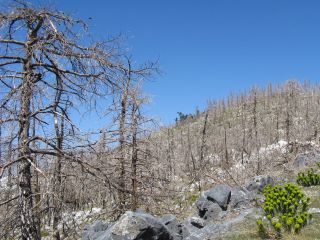
Fire damage in the Taygetos.
Photo by Martin Jones.
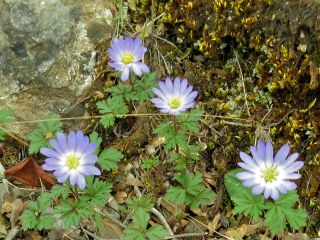
Anemone blanda.
Photo by Martin Jones.
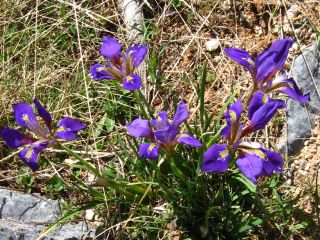
Iris unguicularis ssp. cretensis.
Photo by Martin Jones.
When we reached Pigadia, we were surprised to be met by a local resident, since, due to its altitude, the village is usually occupied only in summer. Clearly the village had once been a thriving community, and it was sad to see so many lovely old stone houses in ruins, colonised by ivy, their slate roofs long since collapsed. There was a lengthy consultation with the local concerning our proposed route back, which he said was impassable. During the conversation which followed, he told us that the impressive Platanus dominating the plateia was planted centuries ago by his ancestors, who had come to the village from Ioannina. Our friend then disappeared, leaving us to eat our picnic lunches. Just as some of the less organised among us were bemoaning the absence of wine from our picnics, the Pigadiotis reappeared, bearing, in the ubiquitous Coke bottle, a kilo of locally made wine.

Iris and anemone growing along the kalderimi.
Photo by Katerina Georgi.
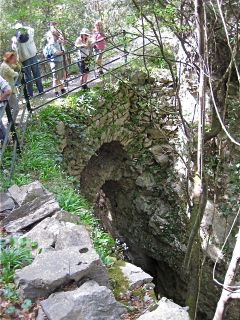
The Pigadiotika Bridge on the Rindomo Gorge.
Photo by Katerina Georgi.
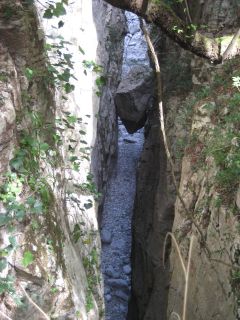
The narrow mule pass.
Photo by Katerina Georgi.
Our thus enhanced lunch over, we finally set off on our trek – a round trip of approximately 3km. It was perfect walking weather and, heading south through the valley, we passed through imposing scenery dotted with Pistacia lentiscus and exquisitely built threshing floors, as far as the beautiful double arched Pigadiotika Bridge on the Rindomo Gorge. From our vantage point on the bridge, shaded by huge Laurus nobilis, we were able to view the point where the ravine narrows dramatically. It was here, in the days when mules carried goods along the river bed, that they had to be unloaded so that they could pass through the narrow gap. From here a breakaway group crossed to the other side of the river and headed along the Koskaraka Gorge before crossing over a modern concrete bridge (built over the original wooden structure), back up the kalderimi on the west side of the valley, then crossing once more to join the rest of the group before we headed back to Pigadia. Along the way, particularly in sheltered pockets, we saw many wild flowers, amongst them Alkanna graeca, Anchusa variegata, Anchusa undulata ssp. hybrida, Hermodactylus tuberosus (now more properly called Iris tuberosa), Ornithogalum montanum, Saxifraga chrysoplenifolia, Scilla messeniaca, Valeriana tuberosa, and a solitary specimen of Orchis quadripunctata.
Back in Pigadia we wearily prepared to make our way home along another tortuous road, but the walk and scenery had been well worth the effort.
Katerina Georgi |


